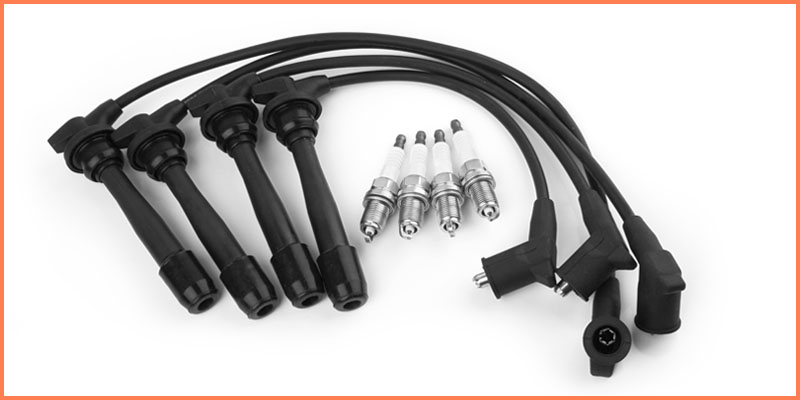As a car owner, you must’ve experienced the pain of your car’s spark plug wire burning from the engine header. It’s a nasty predicament, and getting the repair work done by professionals might break the bank.
You might think – becoming an expert in replacing spark plugs will ease the issue. But prevention is better than cure, as the proverb goes. So, how to protect spark plug wires from headers?
Insulating the spark plug wires with boot sleeves and installing heat shields are the way to go. Read on to know how to use these insulating agents to ensure the longevity of your spark plug.
Why Do Spark Plug Wires Melt from Headers
To solve the problem, we should first understand why spark plug wires burn or melt from engine headers.
Engine headers are an add-on part that makes it easy for the engine to expel exhaust gases from the cylinder. As the expelled gas is hot, the engine header gets heated up sequentially.
The spark plug and its wiring are placed directly beside the header. It’s almost always in close contact with the spark plug wires. When it heats, it transfers that heat onto the spark plug’s wiring most of the time. This is how they burn or melt through prolonged contact.
The Consequence of Spark Plug Wires Burning & Melting
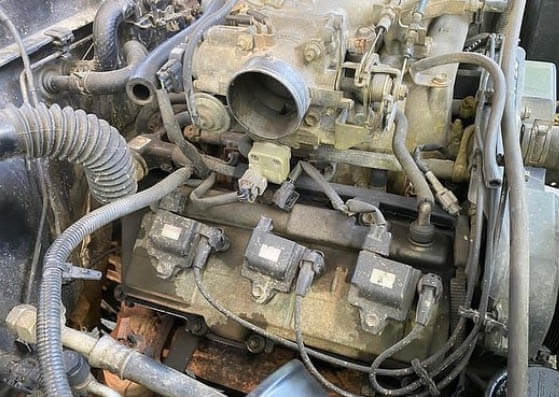
As you know, the spark plug is responsible for setting the initial spark and igniting the engine. If its wiring is damaged, the ignition process doesn’t carry out properly. The lack of electric sparks in the engine’s combustion chamber causes it to burn less fuel, hence decreasing its performance.
How to Protect Spark Plug Wires from Headers?
So, the last thing you want is your spark plug wire getting damaged from the header. If you’ve enough to invest, the best approach is getting a spark plug wire heat shield, boot protector, or boot sleeves. There are cheap options too, like simply sticking plastic caps with electric tape or using zip ties.
Let’s go over all of the processes in detail.
1. Insulative Boot Protectors
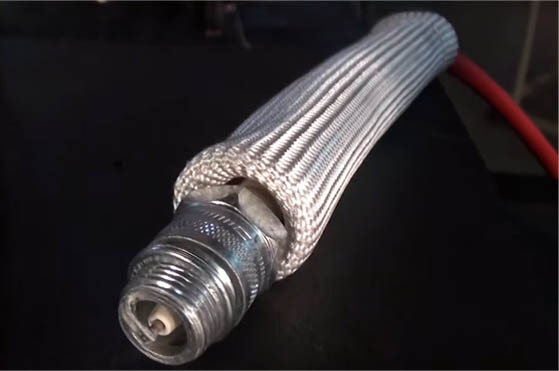
Insulation boots are cylindrical and are fitted in between the cylinder heads of the spark plug wires. They’re relatively inexpensive but highly effective as they can handle temperatures of up to 650 ℃ or 1200 ℉.
Made of thermal-barrier materials, they simply reflect heat, stopping it from reaching your spark plug wires.
For a 1200-degree Fahrenheit protecting insulative boot protector, we’d recommend SHINEHOME’s Insulative Boot Protector. They’ve advanced heat shield technology, which later on you’ll see is one of the best ways to protect spark plug wires.
2. Heat Protective Boots
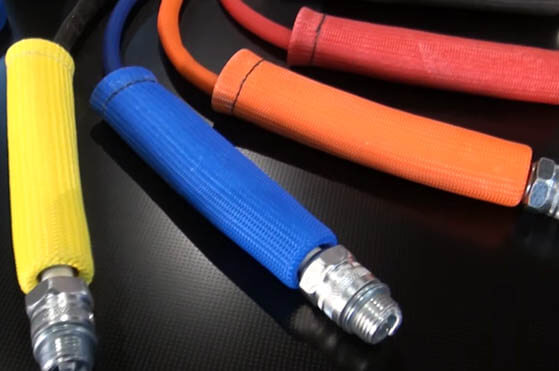
These do a similar job to insulative boot protectors, but they’re made of different materials. They’ve ceramic insulation and stainless steel parts.
They reflect heat easily, creating a heat-protective barrier that can protect your spark plug wires from up to 980 degrees Celsius or 1800 degrees Fahrenheit of heat.
For a model which is certified to withstand 1800 degrees Fahrenheit easily, you can check out KIE’s Heat Protection Boots.
3. Electric Tape With Plastic Caps
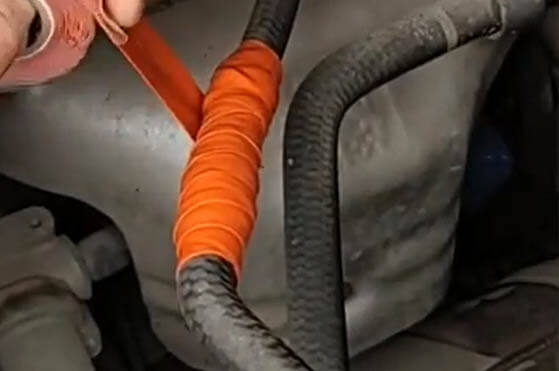
Electric Tapes alone don’t provide enough insulation to save spark plug wires from the excessive heat of the engine header.
But you can get creative and stick plastic caps or similar kinds of insulating materials with enough spacing around the wire. Albeit this is a makeshift solution, it’s the cheapest and offers decent protection if you’ve no other option.
Although most electric tapes have similar heat protection, Wapodeai stands out with its high temperature-resistant, premium waterproof tape at just 5 bucks.
4. Insulative Boot Sleeves
Boot sleeves are made of heat-barrier materials and are simply slid onto spark plug wires. You’ve to apply dialectic grease to make them fit properly.
These are more like an extra layer of protection. If you use insul-sleeves overheat shields, insul-boots, or boot protections, you’ll add an extra layer of protection and see the best results.
You can check out Superfastracing’s 1800-degree Fahrenheit insulative boot sleeves. They’re made of titanium, too, and have an efficient braided design.
5. Fiberglass Socks
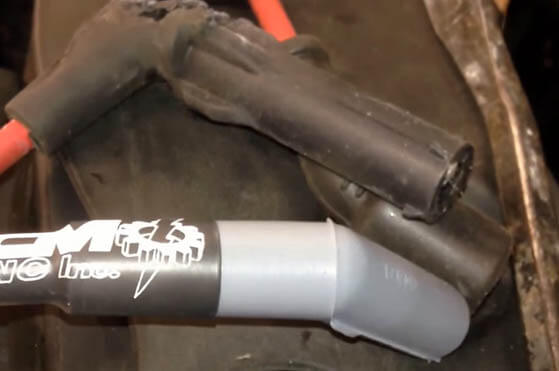
This is another rigid & heat-resistant material used in many heat shields for spark plug wires. They’re made of a heat-insulating silicone material.
One benefit of using Fiberglass socks is their flexibility. You can use them sort of like zip ties to tie them away from the engine header as much as possible. The fiberglass is more than sturdy enough to handle the heat that comes from this greater distance.
You can use regular foot socks, but we’d recommend ZHUBANG’s Fiberglass Sleeve. Using a dedicated spark plug wire sleeve is much better than human socks.
6. Heat Shields
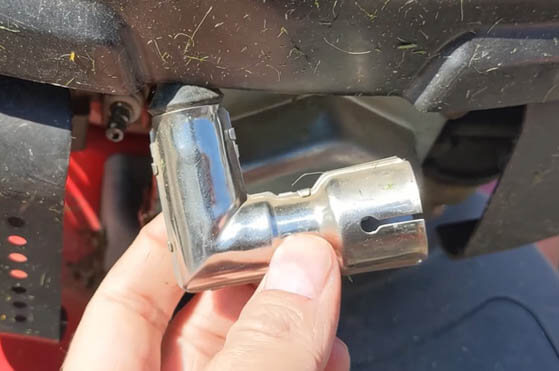
We saved the best for last. These are quite similar to insulative boot protectors but are made of higher quality materials like titanium, basalt, fiberglass, and so on that can provide max heat protection.
For example, Lava Fiber Heat Shield is made from titanium and is capable of holding back even 980 ℃ or 1800 ℉ heat. They’re of a braided design that efficiently dissipates heat.
Other Creative Solutions to Protect Spark Plug Wires from Headers
Besides direct heat insulation, there are some clever tactics you can use to protect your spark plug wires from headers.
1. Use Zip Ties
You can use zip ties to tie your spark plug wires as away from the engine header as possible. This’ll ensure they’re as far away from the heat source as possible. Zip ties help the wires not to get torn and worn out as well.
This technique is so effective; that multiple car manufacturers now put zip ties themselves to have proper wire management in their engines. Some do it on the spark plug wires to keep them away from hazards, and you can, too.
Zip ties are pretty inexpensive. You can get 100 pieces for just $5 on Amazon.
2. Apply Padding
You can apply paddling with a thin cloth in between the spark plug wires and the header. This increases the space between them. The thin cloth leaves room for air to flow, keeping the area ventilated. It can absorb a good amount of heat, too.
How to Install Spark Plug Wire Heat Shields
The most common confusion for home mechanics regarding spark plug wires is heat shield installation. It might seem simple, but there’re some key things to look out for. Follow these easy steps to do it the right way—
- First, make sure the heat shield you bought has 8 or more heat shields. This is because most engines have at least 8 spark plugs, sometimes more.
- Let the engine cool down first before starting the installation process.
- After the engine cools, look at the cylinder head and slowly remove all the spark plug wires.
- When the wires are unplugged, slide them into the heat shields. You’ll notice a ring on the edge of each heat shield. This is what keeps the boots firm.
- If you’ve trouble getting the wires in properly, use some dielectric grease. This lets them slide in smoothly.
- Attach the spark plugs back to their respective places. The installation process is now done!
That’ll work for almost any time of spark plug wire insulation installation, be it insulation boots, boot sleeves, or even fiberglass socks.
Should You Use All Insulating Methods
To best protect your spark plug wires from headers, you might think adopting every single insulating method we’ve talked about is a good idea. It’s not a bad idea if you have the resources, but it’s not necessary. A smarter approach can be taken.
If you notice your wires are a bit too bent and leaning over the header, try the zip tie or fiberglass sock technique. This moves them away from the header, decreasing heat contact.
Again, for cars that don’t have any sort of insulating material on their wires, a heat shield or insulating boot protection approach should be taken.
It’s not about doing more; it’s about doing it efficiently. Doing just one or two of the techniques we’ve talked about is enough to keep your spark plug wires safe.
FAQ
Yes! Heat shields are the best way to protect fragile spark plugs from excessive engine heat and other damages throughout the years. They’re relatively inexpensive, and we’d urge you to make the investment.
It’ll work on paper, but it’s not much effective. Water is a good coolant, but it’ll cool the engine and header for a few minutes only. Adopt this technique only if the situation is too dire.
Spark plug wires might break due to prolonged contact with headers. If you notice your car can’t accelerate as before, it might indicate a broken spark plug wire. Open the hood after the engine cools and check for physical damage to the wire.
In most cases, you’ll notice visible marks and see the wire is damaged for good.
Spark plug wires as hardware parts alone cost $100 to $150, and labor costs extra. If they get damaged due to an overheated engine header, you should replace them as soon as possible.
Conclusion
By now, you should protect your spark plug wires from headers. Hopefully, you’ll now be able to better protect your car.
As a final suggestion, we’d suggest you get good-quality spark plug wires for your car or truck. Cheap ones have lower heat withstanding ability and don’t last long.
Do regular checks on your car engine by opening the hood as well. Ensure the heat shields or insulation boots are still fitted perfectly, and you’re good to go. Cheers!

